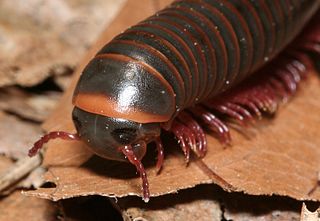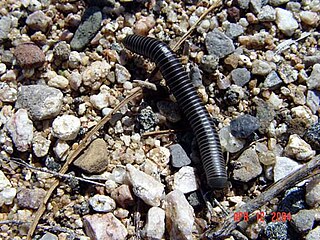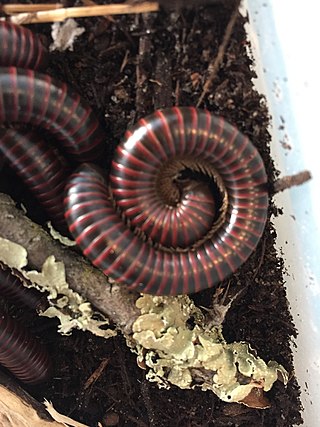
Harpaphe haydeniana, commonly known as the yellow-spotted millipede, almond-scented millipede or cyanide millipede, is a species of polydesmidan ("flat-backed") millipede found in the moist forests along the Pacific coast of North America, from Southeast Alaska to California. The dark coloration with contrasting yellow-tipped keels warn of its ability to exude toxic hydrogen cyanide as a defense. The cyanide secretions are not dangerous to humans, but can cause irritation and pain if it contacts sensitive areas such as the mouth, eyes, or nose.

Spirobolidae is a family of millipedes in the order Spirobolida. The family consists of several genera with numerous species, and is commonly divided into the subfamilies Spirobolinae and Tylobolinae.

William Tinsley Keeton was an American zoologist known internationally for his work on animal behavior, especially bird migration, and for his work on millipede taxonomy. He was a well-liked professor of biology at Cornell University in Ithaca, New York and author of a widely used introductory textbook, Biological Science.

Richard Lawrence Hoffman was an American zoologist known as an international expert on millipedes, and a leading authority on the natural history of Virginia and the Appalachian Mountains. He was a biology professor at Virginia's Radford College for almost thirty years, and curator of invertebrates at the Virginia Museum of Natural History for another twenty years. He co-founded the Virginia Natural History Society, described over 400 species of millipedes, and produced more than 480 scientific publications. He is commemorated in the scientific and/or common names of over 30 animal species, including the valley and ridge salamander and Hoffman's dwarf centipede.

Narceus is a genus of large cylindrical millipedes of the family Spirobolidae native to eastern North America. The genus comprises three or four species, two of which are endemic to Florida, and the remainder forming a species complex. The species of Narceus include some of the largest and most recognizable millipedes in eastern North America.
Hiltonius is a genus of cylindrical millipedes in the family Spirobolidae comprising 10 species ranging from the southwestern United States to Guatemala, with most species being found in Mexico. The genus was named by Ralph Vary Chamberlin in 1918, after Professor William A. Hilton of Pomona College who collected the type specimen of H. pulchrus.

Harold Frederick Loomis was an American botanist and myriapodologist known for his contributions to agronomy, plant pathology, and millipede taxonomy. He worked for the U.S. Department of Agriculture for over four decades, studying diseases of crop plants, and was a colleague of Orator F. Cook. He also made major contributions to the natural history of Central America and the West Indies, naming over 500 species of millipedes in total. He co-described with Cook the leggiest animal on earth: Illacme plenipes, with over 700 legs.
Floridobolus is a genus of millipedes commonly known as Florida scrub millipedes containing three described species: Floridobolus penneri, F. orini, and F. floydi; the latter two described in 2014. All three species are endemic to Florida scrub habitat of peninsular Florida, and F. penneri is considered a critically imperiled species by NatureServe. Prior to the description of F. orini, the genus was considered the sole member of the family Floridobolidae, named by William T. Keeton in 1959, however studies in 2014 have argued that Floridobolus does not represent a distinct family but rather is a basal member of the family Spirobolidae, representing the subfamily Floridobolinae, and tribe Floridobolini.

Paeromopus is a genus of large cylindrical millipedes endemic to the U.S. state of California. All species exceed 10 centimeters in length, and the largest, P. paniculus, reaching 16.5 cm is the longest millipede species in North America. The genus was named by German entomologist Ferdinand Karsch in 1881 and contains four species: three occupying small ranges in the Sierra Nevada mountains and one occupying a large range including the Sierra Nevada and much of Northern California to the Central Coast.
Paeromopus paniculus is a species of millipede endemic to the Sierra Nevada mountains in the United States state of California. Reaching up to 16.5 centimeters in length, it is the longest known millipede in North America.

Paeromopus angusticeps is a species of millipede found in the U.S. state of California. It occupies the largest geographic range of all four species of Paeromopus, occupying much of Northern California in a large arc extending from Monterey County on the central coast, north along the Coast Ranges to Humboldt County, and descending along the Cascades and Sierra Nevada range of eastern California. P. angusticeps is largely absent from California's Central Valley.

Narceus gordanus is a spirobolid millipede native to the southeastern United States. Common names include Smokey Oak Millipede and Smokey Ghost Millipede. Adults range from around 60 to 120 mm in length, up to 13 mm wide, and possess 45 to 65 body segments. The body color is lighter than other species of Narceus, with each body ring a light greenish tan followed by a band of darker tan. N. gordanus also has shorter legs than other Narceus species, and a deeper groove on the head in which the antennae rest.

Chicobolus spinigerus, commonly known as the ivory millipede or Florida ivory millipede, is a millipede species native to the southeastern United States, occurring throughout the Florida Peninsula and Panhandle, as well as southern Alabama, Georgia, and South Carolina. Males normally range from 40 to 85 mm long, females up to 90 mm (3.5 in).

Atopetholidae is a family of millipedes in the order Spirobolida. There are about 18 genera and at least 60 described species in Atopetholidae.
Allopocockiidae is a family of millipedes in the order Spirobolida. There are about five genera and eight described species in Allopocockiidae.
Tingupidae is a family of millipedes in the order Chordeumatida. Adult millipedes in this family have 28 or 30 segments. There are 2 genera and 13 described species in Tingupidae.
Hiltonius pulchrus is a species of millipede in the family Spirobolidae, endemic to the United States. It occurs in California from Kern County to San Diego County.
Tynommatidae is a family of millipedes in the order Callipodida. There are about 12 genera and more than 30 described species in Tynommatidae, found mainly in western North America.
Narceus woodruffi is a species of millipede endemic to Florida. Described in 1959, it is the smallest species of the genus Narceus, with adults measuring up to 50 mm in length and 4 mm in width.

Tylobolus castaneus is a species of millipede in the family Spirobolidae. It is found in Northern California, typically between Fresno and Contra Costa.













